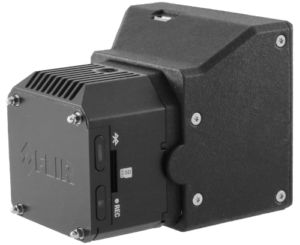 We talk about how cool drones are all the time…right?
We talk about how cool drones are all the time…right?
But did you ever think about the technology that hangs under a drone — hardware that delivers awesome data and superior telemetry?
German thermal-imaging company TeAx Technology is one of many such companies that often perform the unsung “heavy lifting” when it comes to drone-data delivery.
The company recently launched a new add-on, the ThermalCapture Calibrator, to improve UAV-captured measurements which are vital to aerial survey missions.
“The global drone market more and more recognizes the power of thermal data, captured by drone technology for further post-processing,” TeAx CEO Stefan Thamke said.
He added:
“Usually, the market uses standard thermal cores. Under certain circumstances, like strong winds, together with changes of camera orientation, or low surrounding temperatures, measurements can be affected by non-uniformities and limited absolute thermal accuracy. Those can lead to inconsistent, and sometimes wrong thermal datasets. [The] ThermalCapture Calibrator solution, now available for FLIR Vue Pro R … improves thermal accuracy by up to 70 percent.”
Thamke added. TeAx has been aware of the capabilities of an internal shutter and the limitations that come with it. Engineers identified that the best solution would be an external shutter.
Such a shutter provides relevant information needed to calibrate FLIR thermal arrays during runtime. “The external shutter element is heated to provide an always accurate and uniform calibration target. As of today, that is the only way for professional drone operations, to create meaningful, consistent thermal datasets even within challenging environments.”
German agricultural research firm echoes Thamke’s endorsement.
“We are using thermal cameras from TeAx Technology for agricultural research with the goal of creating accurate, radiometric thermal maps,” said Rainer Schlepphorst, a representative of Forschungsinstitut für Bergbaufolgelandschaften e.V.
“We were very satisfied with the solution by TeAx, but the thermal quality of FLIR Tau 2 – especially in terms of accuracy – did not fully meet our expectations,” Schlepphorst added.
“When creating radiometric thermal maps, non-uniformities like cold corners in each thermal image, lead into inconsistent thermal data. Therefore, we were not able to post-process as accurately as we intended to.”
The company contacted TeAx and, as Schlepphorst noted, “TeAx developed a solution, which strongly increased our thermal measurements – we now have access to reliable and consistent thermal data, which allows us to create accurate thermal maps.”
Jason is a longstanding contributor to DroneLife with an avid interest in all things tech. He focuses on anti-drone technologies and the public safety sector; police, fire, and search and rescue.
Beginning his career as a journalist in 1996, Jason has since written and edited thousands of engaging news articles, blog posts, press releases and online content.
Email Jason
TWITTER:@JasonPReagan
Subscribe to DroneLife here.







[…] L’articolo completo è qui […]